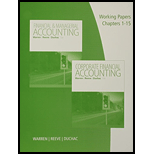
Concept explainers
Process activity analysis
The Brite Beverage Company hollies soft drinks into aluminum cans. The manufacturing process consists of three activities:
- 1. Mixing: water, sugar, and beverage concentrate are mixed.
- 2. Filling: mixed (leverage is filled into 12-oz. cans.
- 3. Packaging: properly filled cans are boxed into cardboard “fridge packs."
The activity costs associated with these activities for the period are as follows:
| Mixing | $216,000 |
| Filling | 168,000 |
| Packaging | 96,000 |
| Total | $480,000 |
The activity costs do not include materials costs, which are ignored for this anal) sis. Each can is expected to contain 12 ounces of beverage. Thus, after being filled, each can is automatically weighed. If a can is too light, it is rejected, or “kicked," from the filling line prior to being packaged. The primary cause of kicks is heat expansion. With heat expansion, the beverage overflows during filling, resulting in underweight cans.
This proce.ss begins by mixing and filling 6,300,000 cans during the period, of which only 6,000,000 cans are actually packaged. Three hundred thousand cans are rejected due to underweight kicks.
A process improvement team has determined that cooling the cans prior to filling them will reduce the amount of overflows due to expansion. After this improvement, the number of kicks is expected to decline from 300,000 cans to 63,000 cans, thus increasing the number of filled cans to 6,237,000 [6,000,000 + (300,000 – 63,000)].
- A. Determine the total activity cost per packaged can under present operations.
- B. Determine the amount of increased packaging activity costs from the expected improvements.
- C. Determine the expected total activity cost per packaged can after improvements. (Round to three decimal places.)
Want to see the full answer?
Check out a sample textbook solution
Chapter 27 Solutions
Working Papers, Volume 1, Chapters 1-15 for Warren/Reeve/Duchac's Corporate Financial Accounting, 13th + Financial & Managerial Accounting, 13th
- what is tikki's ROE for 2008?arrow_forwardAnsarrow_forwardQuestion: A company's cash account has a balance of $851 as of July 31. The bank statement for this account reports a balance of $1,430 as of July 31. There are outstanding checks totaling $840 and a deposit in transit of $60. The bank statement shows interest earned of $19, service charges of $30, a customer's returned check of $100, and a check printing fee of $90. What is the reconciled cash balance that should be reported on the company's balance sheet as of July 31? I need answer in Table format.arrow_forward
 Managerial AccountingAccountingISBN:9781337912020Author:Carl Warren, Ph.d. Cma William B. TaylerPublisher:South-Western College Pub
Managerial AccountingAccountingISBN:9781337912020Author:Carl Warren, Ph.d. Cma William B. TaylerPublisher:South-Western College Pub Financial And Managerial AccountingAccountingISBN:9781337902663Author:WARREN, Carl S.Publisher:Cengage Learning,
Financial And Managerial AccountingAccountingISBN:9781337902663Author:WARREN, Carl S.Publisher:Cengage Learning, Cornerstones of Cost Management (Cornerstones Ser...AccountingISBN:9781305970663Author:Don R. Hansen, Maryanne M. MowenPublisher:Cengage Learning
Cornerstones of Cost Management (Cornerstones Ser...AccountingISBN:9781305970663Author:Don R. Hansen, Maryanne M. MowenPublisher:Cengage Learning Essentials of Business Analytics (MindTap Course ...StatisticsISBN:9781305627734Author:Jeffrey D. Camm, James J. Cochran, Michael J. Fry, Jeffrey W. Ohlmann, David R. AndersonPublisher:Cengage LearningPrinciples of Accounting Volume 2AccountingISBN:9781947172609Author:OpenStaxPublisher:OpenStax College
Essentials of Business Analytics (MindTap Course ...StatisticsISBN:9781305627734Author:Jeffrey D. Camm, James J. Cochran, Michael J. Fry, Jeffrey W. Ohlmann, David R. AndersonPublisher:Cengage LearningPrinciples of Accounting Volume 2AccountingISBN:9781947172609Author:OpenStaxPublisher:OpenStax College Principles of Cost AccountingAccountingISBN:9781305087408Author:Edward J. Vanderbeck, Maria R. MitchellPublisher:Cengage Learning
Principles of Cost AccountingAccountingISBN:9781305087408Author:Edward J. Vanderbeck, Maria R. MitchellPublisher:Cengage Learning





